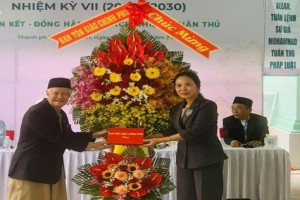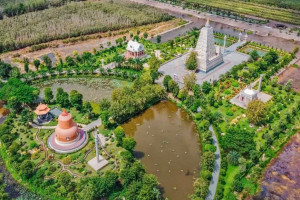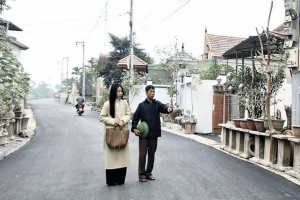
For the past decades, several religions have come and developed in communities of minority ethnic groups in the Central Highlands, and the moral and human values of these religions have created positive impacts and enriched the cultural life in the region.
These religions have integrated in the culture of ethnic groups, proactively engaged in social actions (education, health and charities), restoration of cultural traditions, and preservation of languages of ethnic groups in the region. Besides, these religions have brought impacts that have been creating changes in relationships and traditional social institutions, and taken advantage of by hostile elements, causing social and political complications.
Currently, in addition to the tradition of polytheistic worship, religions of Catholicism, Protestantism, Buddhism and Caodaism have been practiced in the Central Highlands for a long time. For recent decades, several religious phenomena have appeared in the region, including sects known as Ha Mon, Cross of Jesus Christ, Vietnam Christ Protestantism, Po khap Brau, Ami Sara, Canh tan Dac sung, etc.
As stated by Assoc. Prof. Hoàng Thị Lan from the Religion and Belief Institute under Ho Chi Minh National Academy of Politics, when developing into the ethnic communities of the Central Highlands region, religions such as Protestantism, Catholicism and Buddhism, given fine cultural and moral values, have certain positive impacts on the social and cultural life.
When religions developed in the ethnic minority communities, religious moral values and teachings for human interactions and human behaviors towards supreme beings and the nature both have similarities, differences and new points, as compared to the traditional worship, creating attraction and contributing to change several perceptions, the moral standard and lifestyles of people in the region. Followers of these religions have conscientiously observe religious teachings, proactively engage in own moral cultivation, adopt positive lifestyles, take well care of their families and fellow human beings, and actively get involved in social actions. It’s practically showed that, in communities of religious followers in the Central Highlands, there have had no illegitimate cases of divorce and family mistreat or violence; social evils have rarely occurred.
When introduced and practiced in the ethnic communities of the Central Highlands region, some religions with simple and economical rites have contributed to transformed outdated perceptions and customs and lengthy and costly rites of the traditional worshipping practices, contributing to change people’s cultural ways of life in more positive and civilized manners. Children have been better cared and encouraged to pursue higher education levels; families, communities and villages’ affairs are guided to be better organized and more civilized.
After following religion, especially Catholicism and Protestantism, people in the Central Highlands have changed their lifestyles, suiting new conditions. Christian people, when falling ill, have no longer invited shamans for deporting evils and ghosts, and instead come to medical centers; wedding and funeral have been religiously organized with fewer expenses, without many backward rites and customs.
Facilitating with religions, people in the region of Central Highlands have been able to engage in community prayers and religious practices together, to have more opportunities for social contacts, mutual assistance and new knowledge.
In the development process, religious organizations in Central Highlands have adopted measures for integration and adoption of fine cultural values and identities of ethnic communities in return. Given a cultural integration orientation, the local Catholic Church has strived to meet Catholic practices of ethnic people by providing training for dignitaries and deacons who are ethnic minorities, translating the Bible into ethnic minorities’ languages, teaching ethnic languages, preserving artifacts of ethnic cultures, retaining certain cultural activities and practices of traditional worship, and using traditional gongs and dresses in religious festivals or church masses. Many worshipping churches built in the Central Highlands have a mixed architecture of the traditional Catholic model and communal house (‘nha rong’) of ethnic minority villages with traditional patterns of ethnic minority groups.
Buddhism has adopted initial changes for adapting to the cultural identities of the ethnic minority communities in the Central Highlands. Roofs of pagodas, such as Khanh Lam and Hue Chieu in Kon Tum province, have similarities to nha rong; elephants have been used in a Buddhist procession during the Buddha’s Birthday Festival in 2019 in Dac Lak province’s Lak district.
In addition, religions in the Central Highlands have made proactive contributions to social, charitable programs and environmental protection launched in ethnic minority communities in the region. At some areas, local religious organizations have established kindergartens, vocational training schools, social sponsoring centers and boarding schools for disadvantaged children. Some local religious organizations have also set up health clinics providing free heath checks and medicines to disadvantaged locals, and models for environment protection, contributing to raise locals’ awareness in the environmental issues.
PTT




